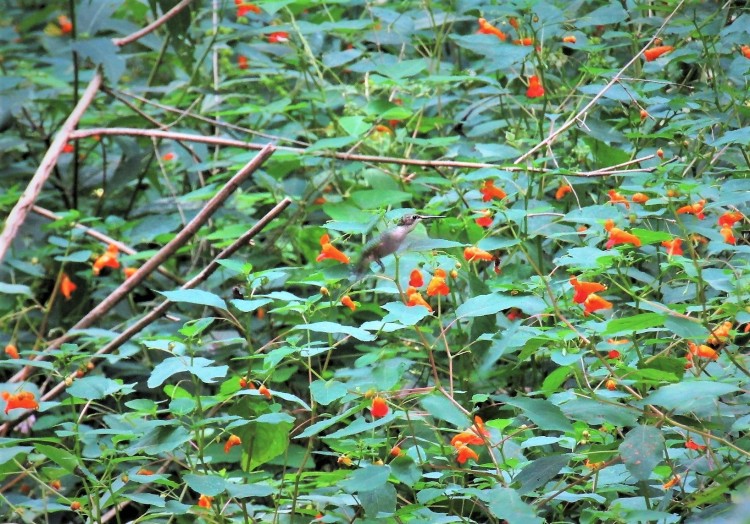
What’s it like to be a hummer in a Jewelweed patch? Buzzing-twittering through a jungle of bright orange nectar horns big as your head… whizzing in pursuit of companions… hanging in space as your tongue curls around sweetness….
Most birds move through the world with an ease we can only envy – but some, like hummingbirds and swallows, seem truly at home in the air. I’m just the earthbound observer – sweating, mosquito bitten, trying to hand-hold a little camera still in low light – it’s nearly impossible to track this tiny creature’s darting movements. The hummers don’t appreciate my presence, and twitter with annoyance from the back of the flower patch. My pics are not like the ones you’ll find on google images, close-ups of hummers isolated in space. Rather, these are hummers at home in their world – you’ll have to search for the bird, as I did.
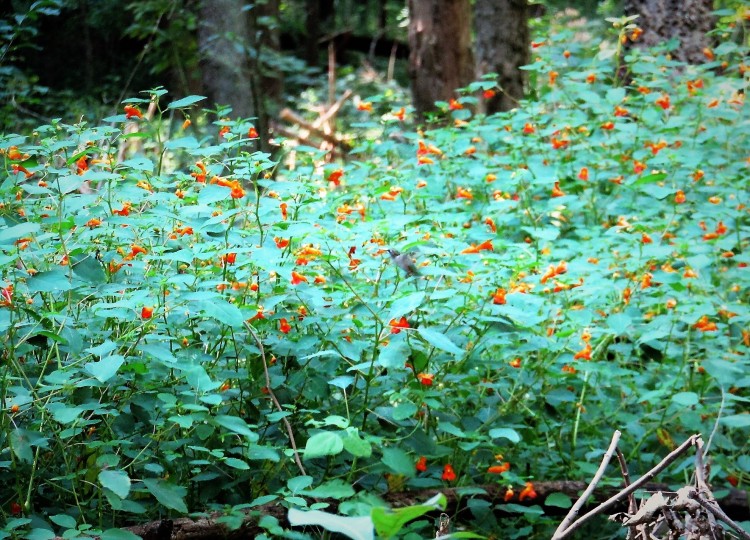
As any Ruby-throat knows, a Jewelweed patch is the place to be. The sheer masses of blooms ensure a good meal of nectar and small insects. In fact, it appears that the plant and the bird have co-evolved, to the point that hummingbirds are the best pollinators of Spotted Jewelweed, Impatiens capensis. Quoting from this great article: https://nationalzoo.si.edu/migratory-birds/news/flower-specialist
“A study found that even though bumblebees also visit jewelweed, hummingbirds do a far better job at pollinating it. This is because when a hummingbird visits the flower, it causes the flower to wobble and this wobbling rubs lots of pollen on the bird’s face. When the bee visits jewelweed, its movements are more delicate. The flower stays still and the bee leaves with less pollen to take to the next flower.”
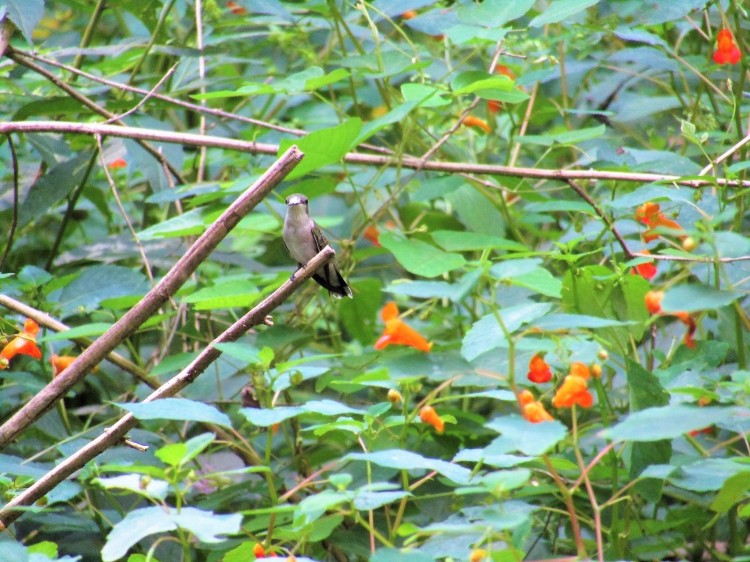
I was baffled when I saw the white blob on this young hummer’s face, but after reading the above, realized it is indeed Jewelweed pollen.
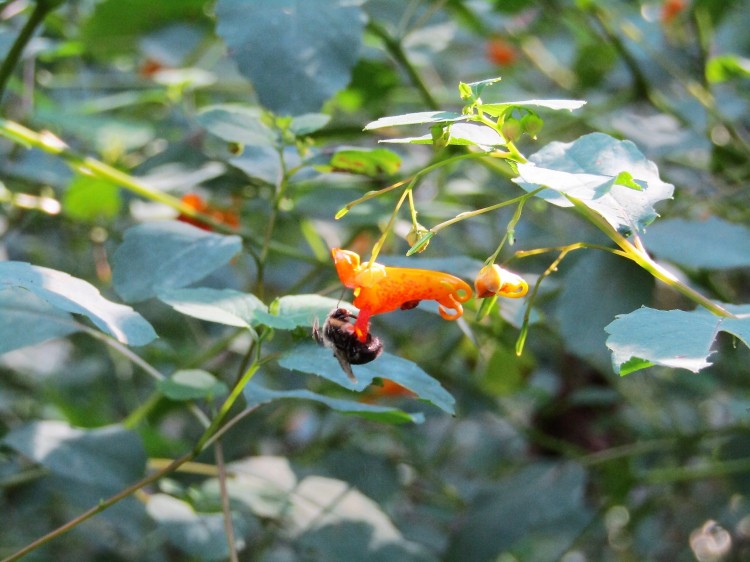
Obviously, the continued presence of healthy Jewelweed patches is very important in our forest. I remember, back before the deer arrived, how abundant the jewelweed was – and the hummers as well. Because tender jewelweed is a very preferred deer browse, patches of this plant have taken a real hit in recent years. Browsing doesn’t kill the plant, but does reduce or eliminate production of showy flowers. The plant then reproduces with the help of tiny self-pollinating “cleistogamous” flowers, but this cuts pollinators out of the loop.
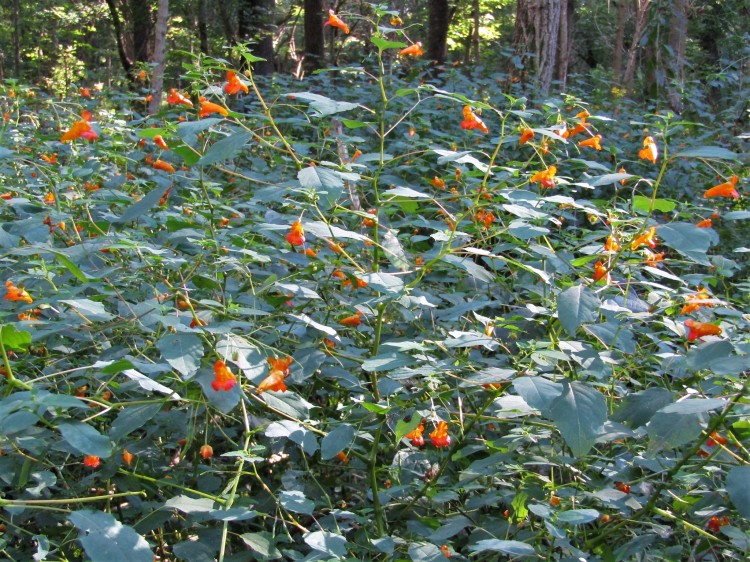
The jewelweed patch in these pics is one where I used natural “deer exclusion” barriers. This consists of – you guessed it – piling brush, like large cut honeysuckle limbs, throughout an area as discouragement to entry. It has to be very high and very dense to do it’s job, but the results are worth it.
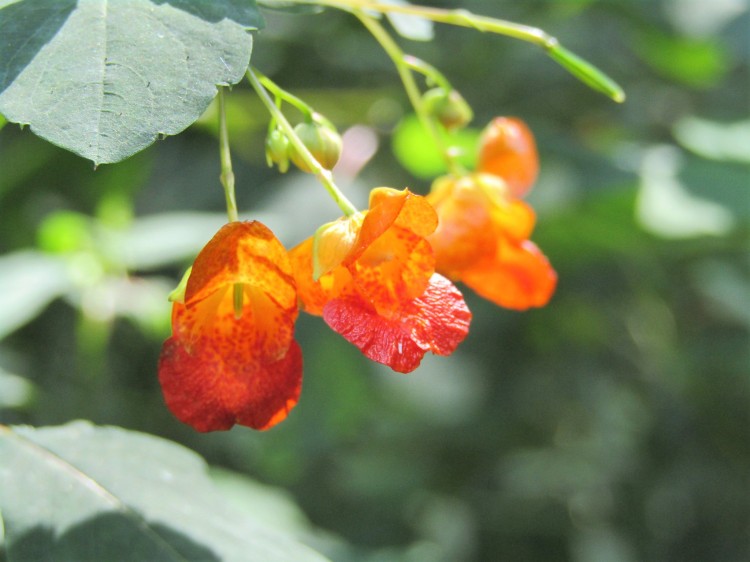
Spotted jewelweed is surprisingly under-utilized in native plant gardens, considering its value to hummingbirds. As an annual, it’s very easy to grow in moist soil and can take a fair amount of shade. Right now is the time to get seed, since the fat green pods are ready to go off – “touch me” says the plant.

By September Jewelweed usually dies back from late season dryness, but this year’s wet summer has been very good for the flowers. It’s a fine excuse to get out on the trail for some hummingbird watching!
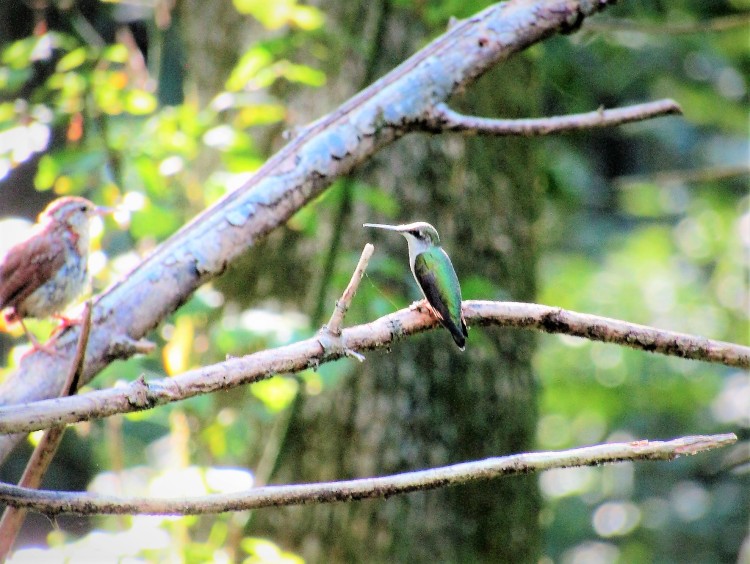

Elizabeth
Great photos, especially with a hand held camera!
LikeLike
oneforestfragment
Thanks Elizabeth! Just had to mention that about the camera, as I’m trying to practice “stillness” in order to get bird pics with the lens extended. Surprisingly hard!
LikeLike
joan Jardin
Beautiful pictures and a great explanation of the plant. We have that along our shoreline at our cottage in Winneconne wi. Cut most of it down not realizing its value until I saw a hummingbird enjoying the little patch I had left. I will know better next time. Enjoy your website.
Joan
LikeLike
oneforestfragment
Thanks Joan! Jewelweed tends to be underappreciated, perhaps because it’s so common and “weedy”.
LikeLike
tonytomeo
Do hummingbirds make it obvious that they do not appreciate your presence? I have seen them chase arborists who get too close to their nests, but otherwise, they do not seem to be too bothered by people. While plucking the old Peruvian lily flowers, I noticed how close the hummingbirds get just because they find me to be interesting. They have gotten close enough for me to feel the tiny draft from their wings. They sometimes look me straight in the eye for a few seconds, as if wanting to get better acquainted, but lacking a common language with which to do so.
LikeLiked by 1 person
oneforestfragment
That’s so interesting, I’ve never felt the draft of their wings. Sometimes they approach close, especially if I have a red bandanna. These looked to be young migrants, they were very active and skittish.
LikeLiked by 1 person
Jim Sky
I think sometimes they are being territorial with their food. They certainly, guard their favorite feeder from others when they can. I have been swooped twice, both times close enough to feel their wake and hear their wings. always near a feeder.
Amazing how much sophisticated behavior can fit in that tiny brain. I am not surprised that they might be curious about you. Now there is something you can’t buy – a hummingbird wanting to know you.
LikeLiked by 1 person
tonytomeo
My colleague finds it amusing that something as tiny as a hummingbird can be so intimidating. If I try to back away from one, it just moves in closer while my friends laugh.
LikeLiked by 1 person
Owen C. Hardy
Fascinating post. We too cut back our jewelweed, thinking it was invasive and, well, a weed. No more! Where can we get seeds, please?
LikeLiked by 1 person
oneforestfragment
Thanks Owen! If you live near any creeks or low wet areas you can collect your own seed. The orange Spotted Jewelweed is most popular with hummers. This nursery has seed and explains how to germinate:
https://www.prairiemoon.com/impatiens-capensis-spotted-touch-me-not-prairie-moon-nursery.html
LikeLike
Jim Sky
Always fascinating. Hummers are dear, interesting creatures. Thank you.
I was curious about the curative effect of jewelweed reported for poison ivy caused skin rashes. Our new house came with quite a bit of poison ivy. One of us contracted a bad case of poison ivy after pulling roots (all parts are poisonous). This study seems to think jewelweed has some positive effect in a mash form. As I understand from the abstract, the effect was not greater than using soap and water to clean the wound.
https://www.ncbi.nlm.nih.gov/pubmed/22766473
So in a outdoors pinch it could be worth it to pound some jewelweed and rub it on the wound, but vigorous cleaning with soap and water is the thing that is most likely to affect the severity of the rash. Why not both? I don’t know.
Aside: Mid summer, I looked up to see what kind of tree I had been ignoring by our back door since we moved in. I did not recognize the 20 foot tall tree, until later I was told it was poison ivy. Two 2″ thick vines had grown up a tree of another species and produced their own branch-like structures. These pseudo-limbs sported huge “poison ivy shaped leaves” in the typical groups of three. It was sort of like realizing I had been walking past a grizzly all year without noticing. Anyway I am looking for some really big jewelweed.
LikeLiked by 1 person
oneforestfragment
thanks Jim! I suppose anything that helps remove the urushiol oil from your skin quickly is helpful. There are some of those Poison Ivy “trees” in this forest too. We used to tell schoolkids on hikes “if the vine is hairy, be wary”. Some of my fellow forest stewards would like to cut all vines off the trees. I have nothing againt Poison Ivy and will not molest it in the forest. It’s good eating for wildlife, both leaves and berries.
LikeLiked by 1 person
jdillow97
Absolutely fascinating-coevolution, especially between predator and prey, is one of my main interests; interesting to see how it’s applied to pollinator as well! I’d love to read more from you about it!
LikeLike
oneforestfragment
It is fascinating – plants and pollinators have an ancient relationship that has created the remarkable array of flower shapes and colors. Really enjoy your blog too!
LikeLike
Joseph Jannuzzi
I love the Jewelweed that grows around the Great Lakes. The hummers that come into my yard go first to the poke plants and then the jewelweeds. We have a yellow and an orange variety around here. I’ve also read about it being a Native American remedy and prevention of dermatitis from poison ivy. The folk lore goes jewelweeds typically grow in areas where poison ivy grows also. The juice within the leaves and stems of jewelweed is supposedly like the juice from aloe vera plants and will help relieve poison ivy rash and can be applied at time of exposure to minimize a rash developing. I don’t know but I did buy a local soap makers jewelweed soap and keep it around just in case.
Oddly, this folklore is what got me in trouble with the local code enforcement who cited me for having “noxious weeds” in my yard. It seems their belief was since jewelweed is also called “touch-me-not” that was a reference to it being related to poison ivy and would cause dermatitis. I am never amazed at the ignorance of people when it comes to having nature around. I vainly explained the “touch-me-not” references was to the ability of the plant to shoot its coiled up seeds fairly long distances. The chipmunks love the seeds and in my one little patch in back that I was allowed to keep I just walk through it every autumn and send seeds flying to ensure the patch is re-seeded.
LikeLike